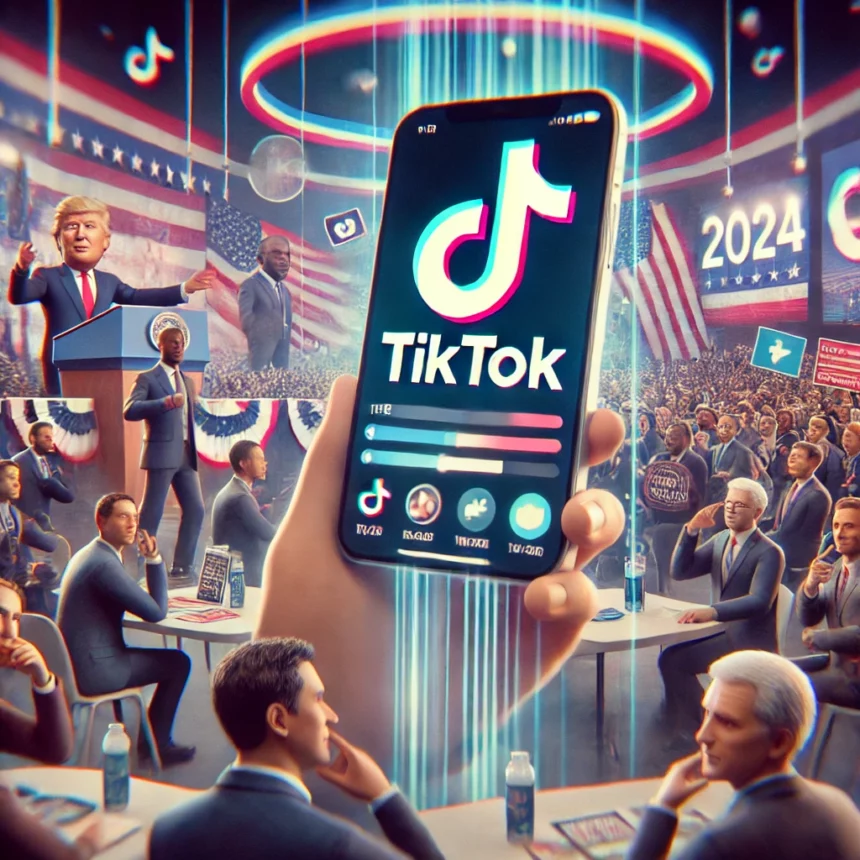Summary by Geopolist | Istanbul Center for Geopolitics
The article examines TikTok’s role in U.S. politics, particularly in the 2024 election, as candidates like Kamala Harris and Donald Trump utilize the platform to reach younger audiences. TikTok’s short, viral videos offer a way for political figures to connect on a more personal level, bypassing traditional campaign formats. Trump has adapted well, using humor and short clips with celebrities, while Harris is still refining her approach. Despite concerns about its Chinese ownership and past political scrutiny, TikTok is shaping how candidates engage voters, particularly the younger generation.
TikTok has a distinct ability to blend entertainment and politics, making it a tool for political engagement that feels more authentic and relatable. Harris, known for her vibrant personality, has the potential to connect with voters through her humor and charm, but her content so far has been limited in terms of leveraging TikTok’s interactive features. On the other hand, Trump, despite initially criticizing the platform, has embraced it fully, using the app’s format to humanize his image and create viral moments with influencers.
The broader implication is that TikTok is evolving from a social media platform into a political force. With over 170 million U.S. users, the platform reaches a significant part of the electorate, especially younger voters. Politicians who master TikTok’s specific content style may gain an edge in influencing public opinion. As the 2024 election progresses, TikTok could play a decisive role, not just in the candidates’ visibility, but also in shaping the political landscape. The app’s influence on political discourse highlights a new era of digital campaigning.
Read the full article below.
How TikTok Is Influencing the 2024 U.S. Presidential Election
In 1924, the U.S. presidential race between Calvin Coolidge, John W. Davis, and Robert La Follette was the first to navigate around a new, democratizing development: radio. Previously, if you wanted to hear the candidates speak, you had to be there in person, and certainly that couldn’t allow for everyone. While kicking the tires of the novel technology, someone in the ultimately victorious Coolidge campaign recognized what was resonating and stuck a succinct bit of wisdom in a memo for posterity: “Speeches must be short.” The political soundbite was born.
Cut to 100 years later, and the message is the same but the medium different—it’s time for adults to accept that TikTok is more than a video-sharing app that teaches your niece acrobatic dance moves. Snappy and effective political videos couched between baking tips and clumsy zoo animals will take an active role in determining our future.
The 2016 U.S. presidential election was certainly the Facebook election and when the idiotic term “fake news” was popularized. (Why this phrase, as opposed to just “lies,” caught on will forever irk me.) 2020 was the election year made for Twitter, where one could see COVID-19 stats updated in real time, watch livestreams of urban riots, and then hit like on Randy Rainbow’s musical parodies and Sarah Cooper’s lip-synch gags. (Google those names if they don’t ring a bell; you saw them both, trust me.) Now, in 2024, an increasing number of our culture’s reverberant memes have their origin on TikTok.
Launched internationally in 2017 and owned by the Chinese company ByteDance, the app was officially declared the most popular thing on the internet, even surpassing Google, by the web security and performance group Cloudflare in 2021. This may sound a bit shocking, but ask your co-workers about where they got that recipe, how they devised that House of the Dragon theory, or why they are jerking their neck that way when a Charli XCX song comes on at the drugstore, and the root of it will likely be “I saw it on TikTok.”
The app became a bit of a political hot potato in the United States in July 2020, when then-President Donald Trump told reporters on Air Force One that he was going to use his executive powers to ban it. Secretary of State Mike Pompeo called it and other Chinese-owned apps and technology “Trojan horses for Chinese intelligence,” and some companies, such as Wells Fargo, directed their employees to remove it from their work phones. TikTok swore that data from its U.S.-based users would stay in the United States and hired a former Disney executive to maintain a domestic operations headquarters in Los Angeles. Some suggested that Trump’s animosity toward the platform had less to do with security and more to do with the fact that he was steamed some K-pop fans and TikTok users colluded into duping his campaign into thinking there’d be a bigger turnout at a rally in Tulsa, Oklahoma, in June 2020, but the Biden administration also shared some misgivings, leading to congressional hearings in 2023 and ongoing scrutiny.
But most users either don’t know or don’t care about any of that. It’s far too seductive to stare at your phone and miss your bus stop. TikTok has certainly launched some of its users into the celebrity class, but for most of its 170 million American users, it is purely passive. People use the term “scrolling,” but to open TikTok on your phone is more like being yanked into a powerful riptide. Even if you follow only your close friends, the “For You” stream (more like a tidal wave) quickly sniffs out what holds your interest and hoses you down with more, more, more.
It’s all video content, and while there is a comment section, it’s not like Facebook, which was built to fuel conversations (like the one that got your cousin barred from family get-togethers), or X (formerly known as Twitter), where posts expand their reach with witty badinage and/or “Can you believe this clown?”-style dunking. The success of TikTok is its engulfment. And while one can access TikTok from a computer, this app, more than the others, is really meant for your phone. The video frame takes up the entire screen of that thing that sits in the palm of your hand every time you find yourself with a 0.01-second gap in activity, lest you allow yourself time with just your thoughts and the horrors of existence. (Or is that just me? I don’t think it’s just me. I hope it’s not just me.)
Importantly, these looping short videos are resistant to ostentatious production values. The technology behind it is a mix of the dead platform Vine, in which clunky in-camera edits enabled people to shoot shareable clips of one another on the go, and the lip-synching software of Musical.ly, which ByteDance acquired in 2017. Yes, you could deploy expensive props, postproduction effects, and expensive editing software into your video, but that just reeks of effort. The dance crazes that turned TikTok into the must-have app usually start in some teen girl’s bedroom in front of her mirror. Rudimentary creativity still seems to be what drives a video to virality.
And that’s part of what still makes a great TikTok video. Something with scrappy “theater kid” vibes—like a woman cutting away from herself asking a question and then affixing a fake mustache to respond as a typical man—still resonates a lot more than anything that feels too “profesh.” Whether that survives much longer, especially with the presidential candidates jumping in the pool, remains to be seen.
Kamala Harris, then a U.S. senator and presidential candidate, dances as she attends the Democratic Polk County Steak Fry in Des Moines, Iowa, on Sept. 21, 2019.Joshua Lott/Getty Images
Vice President Kamala Harris created a TikTok account on July 25 and accrued some 4.2 million followers in under two weeks. (It was a busy two weeks.) She’s following six accounts but has her settings such that we can’t see who they are. I guess we’ll suss that out when we see which dance moves she uses later in the campaign. Trump, despite that 2020 pledge to ban the app, joined the platform in early June and gained more than 9 million followers in about two months. He’s following two accounts: that of his running mate, J.D. Vance, and “Team Trump,” an official arm of the campaign that has under 250,000 followers and rarely posts. Trump has never been a man uneager to put himself in the spotlight.
Trump’s most viewed video is his announcement that he was joining TikTok. “The President is now on TikTok,” UFC champ Dana White declares from the cement-encased backstage area of an arena. Set to Kid Rock’s “American Bad Ass,” the Republican candidate shambles around the audience and waves, points, and poses for a selfie. We see shots of the crowd, some of whom are enthused; others are more focused on their drinks. It’s a collection of not-very-compelling images and taps out at 13 seconds, with Trump mugging, “That was a good walk-on, right?” at the end.
His second-most popular, with almost as many views, is his second chronologically, and it’s where he shows he understands what makes the platform special. The six-second clip is a classic two-shot, with pro wrestler/YouTuber Logan Paul on one side, the former commander in chief on the other. They step forward to square off like fighters against each other, a championship belt held between them. The camera pushes in as the hit song “Way Down We Go” by the Icelandic blues-rock band Kaleo plays in the background. It looks as if they are about to come to blows when they both crack smiles and hug. “Yo, I was scared!” Paul says while others in the room chuckle and applaud. It’s a fantastic clip.
Few others so far have the same juice. There’s a clip of him and Jake Paul (Logan’s boxer brother) muttering that Harris isn’t very smart, which seems to be in response to something she said, but whoever edited it clipped it poorly. The video is confusing, and it did lousy numbers.
More successful (over quadruple the views) is another clip in which he and Adin Ross, a video game streamer, do a preposterous hip shake to a bass-boosted version of “The Star-Spangled Banner.” It lasts all of five seconds, and while a minor work of outsider art all on its own, it is targeted to those who recognize it as a callback to when Trump used to do the same dance to the Village People’s “Y.M.C.A” on the campaign trail in 2020. Back then, many ridiculed his moves (and when you see them, you’ll learn why), but revisiting this inelegant shimmy with a 23-year-old internet phenom shows that the twice-impeached man who was found guilty on 34 felony counts of falsifying business records and liable for sexual abuse in a civil suit can, it seems, make fun of himself from time to time. Quite frankly, it’s the most humanizing thing I’ve seen related to Trump in years.
U.S. President Donald Trump dances at the end of a rally in Carson City, Nevada, on Oct. 18, 2020. Mandel Ngan/AFP via Getty Images
Across the aisle, though, Harris has been hailed as America’s Fun Aunt and been something of a “meme queen” since the day she said, “We did it, Joe,” over the phone back in November 2020. Even before she took the baton from President Joe Biden, internet users delighted in her sui generis aphorisms, such as, “You think you just fell out of a coconut tree?” and the time she lowered her voice to say, “Hello, Senator Bennet.” (I really do like that one myself.) Her campaign, especially with her Midwestern Care Bear running mate Tim Walz, has so much material that the fans, so far, are doing all the work.
Though her account is still somewhat new, there aren’t many TikTok videos on Harris’s official page that exploit the virtues of the platform. There’s a video of her and Walz waving to a crowd. No captions, no music—just them waving. An earlier one, from before she selected Walz as her running mate, is just her waving at a crowd. I guess she’s sticking with a theme.
Other videos deploy music and editing—such as a recap of her visit to the set of RuPaul’s Drag Race—but nothing in the frame is happening for the TikTok audience. A staffer just had their phone out. At least they got a super brief moment backstage during her Atlanta rally with Megan Thee Stallion shouting out the “future president of the United States” and adding her signature “ahhhh.”
Harris’s most viewed TikTok by a substantial margin is a jokey video in which NSYNC’s Lance Bass faces front and asks, “Hey, Kamala, what are we gonna say to Donald Trump in November?” He turns his phone to reveal the vice president, who answers with the punchline “Bye, bye, bye,” as the boy band’s 2000 hit of the same name begins to play. It’s rudimentary (no editing), and the sound is janky (she’s mixed too low), but it is effective. She’s got an incredible smile, and even though Bass is in the foreground, this TikTok stars Harris’s laugh lines. She comes across as very agreeable and approachable. If she can pull off some more of these, she’ll be unstoppable. (A preexisting account with fewer followers, Kamala HQ, is a little more playful and often cuts together news clips set to music or features the young camera-ready staffers setting up visual punchlines.)
These next few months aren’t just a test for American voters but for TikTok as well. If the app were ever going to get yanked from the teenage bedroom and plopped into the hands of heavily funded interests, now’s the time. So far, the viral videos about Harris en masse are outpacing the ones from Harris. You can open the app, throw her name into the search bar, and start crunching the numbers yourself. One simple 19-second clip with nearly 2 million views from a user called meatball2702 confesses guilt and self-awareness for falling for the “Yes Queen” propaganda surrounding Harris. “That’s a politician,” the user says laughing, before adding, “I’m still gonna vote for her, but I don’t like feeling like I want to vote for her.” Could anyone within the campaign ever come up with such an authentic expression of political intention? More importantly, they don’t have to when others are doing it for them.
Some reading this might tut-tut and say TikTok is exclusively for young people and has no relevance to the wider populace. It is true that it skews young, but keep in mind that the Pew Research Center reported last year that a third of adults under 30 in the United States regularly got their news from TikTok. Moreover, even if you are so Methuselan that you only use your phone to check your stocks, see how the Yankees blew their lead again, and, in utmost retro form, make phone calls, these seeds of our culture sprout everywhere. Silly memes germinate into ideas. And they don’t just fall out of a coconut tree.
By Jordan Hoffman
Source: Foreign Policy








